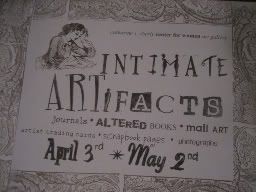How does a call for mail art work?
Consider the definition posted by the
Sticker Dude, which I quote here: "For those who do not know what a Mail Art Call is or how to respond to one, here is an outline of how a mail art collective project usually works: A mail artist formulates an idea for a project and sends out a 'call' to other artists for artwork that fits the concept of the project. The mail artist then waits for responses to the call. Traditionally, mail art collective projects have no judge or jury to select or reject the works of art. The artist who made the call then gathers together the works received and documents the project. This documentation, including a complete list of contributing artists is sent to all the participants. So making the 'Collective Work of Art'."
How did you formulate the idea for this project?
"intimate artifacts" has many origins, most of them particular things, or artifacts, that mean so much to me that they are more than merely personal; rather, they are intimate. For example, Jeanne K. my co-curator, embroidered a baby bib for me when she was student in our M.A. program and I was pregnant with my second child. She embroidered a counted cross-stitch blessing on it, a common crafty gift in our culture; I got a lovely one from my cousin Ellen with animals on it. Jeanne's use of predicate logic notation, is, I believe, unprecedented in any culture:

I often tell my students that those who think logic is the opposite of passion have yet to actually study logic. For the study of logic is a like a carnival ride with thrilling highs of clarity and insight interspersed by crushing lows of paradox and confusion. Jeanne proves, by a series of small x's, how logic and love can come together right in front of your nose. (Or your baby's nose, as the case may be; he turned out to be just as cute as stipulated.)
Are there any size restrictions on submissions?
No, but most of the art received so far falls into one of three binders: Small (3"x5" and under), Medium (3"x5"-5"x7"), and Large (5"x7"-8.5x11"). A handful of "extra-large" items are promised including a mixed-media 3-D volcano; any framed art we get will be hung on the wall--but we are sharing limited exhibition space with the paintings in the Athena Art Society's show, Stepping into Spring, and there's not room for much more. Books we receive will be displayed on a revolving wooden bookstand that my husband made for me one XMAS. This would be another one of those intimate artifacts mentioned earlier. We are also planning to install a couple of bulletin boards on tripods and put some of the collage work up that way, creating a big collage out of lots of little small ones.
 What's the gallery space like?
What's the gallery space like?The Catharine S. Eberly Center for Women has a fairly small and very feminine gallery space. First, there's a hallway, with offices and computer labs on either side. At the end of the hallway (birth canal?) there's a small room (womb?) with chairs and a coffee table. In addition to stopping buy to check out the art, visitors to the center use the room as a place to have a good cry or pump breast milk, with an appropriate note on the door which you can shut--even if you just want to be alone to contemplate the art. Indeed, one of my students who visited it for the first time said he felt as if he were
trespassing--as if he had somehow stumbled into the ladies room by mistake. I thought, oh how instructive! For now he has some inkling of a whisper of a clue of what so many "co-eds" experienced, especially those women on whose shoulders professors like me stand, as they made their way through the halls of academe. It's one of my favorite places on campus that very few people know about.
 What's going to happen to the art after the show?
What's going to happen to the art after the show?Most of the submissions, especially those that fit in binders, will be donated to UT libraries. However, you may exhibit work and then retrieve it after the show (e.g., altered books, sacred scrapbooks, 3-D volcano sculptures, etc.). Even though none of the art will be for sale, please assign a price to any work you plan to retrieve for insurance purposes. Art can be picked up after the exhibit on May 5 from 2-5pm in Scott Hall 2022. There will be a make-and-take for you featuring paper punches at this time to thank you for sharing your artwork.
What is a "make and take"?In scrapbooking lingo, a "make and take" is a free craft project that you can
make in 15 minutes or so, usually at a vendor's booth at a convention, a scrapbooking store, or cropping party, that you can then
take with you. In this case we will be crafting in my office!
What other acknowledgement will contributors receive?All contributors will receive documentation verifying their participation. In other words, everyone who submits art to us will get thank you art from the co-curators on which we will record any feedback that your work elicited in the guest book at the show. The goal of most networked art shows is to create a community through the exchange of art between individuals and our exhibit is no exception to this rule.
Is it too late to submit to the exhibit?No, not yet! The deadline for submission is March 31st 2008. Mail items to intimate artifacts/Department of Philosophy Mail Stop #510/ University of Toledo/ Toledo OH 43606. The opening of the exhibit will be on Thursday April 3rd with a reception from 5-7 at the Eberly Center.










